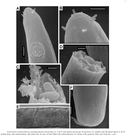
|
World Database of NematodesLinked to the Marine Biology Section, UGent |
| Start | Browse taxonomy |
Search taxonomy |
Search literature |
Search distributions |
Identification keys |
Media gallery | Editors | Statistics | Citations | Match taxa | Contact | Login |
WoRMS taxon detailsAstomonema southwardorum Austen, Warwick & Ryan, 1993
121747 (urn:lsid:marinespecies.org:taxname:121747)
accepted
Species
marine
Austen, M. C.; Warwick, R. M.; Ryan, K. P. (1993). Astomonema southwardorum sp. nov., a gutless nematode dominant in a methane seep area in the North Sea. <em>Journal of the Marine Biological Association of the United Kingdom.</em> 73(03): 627-634., available online at https://doi.org/10.1017/s0025315400033166 [details] Available for editors
Etymology Astomonema southwardorum is named after Drs. Alan and Eve Southward in recognition of their pioneering work on symbiotic...
Etymology Astomonema southwardorum is named after Drs. Alan and Eve Southward in recognition of their pioneering work on symbiotic associations in marine invertebrates. Alan Southward was present on the cruise of the RV "Resolution" when this species was first collected and Eve Southward has kindly made the TEM photograph available to us and is presently working on the micro-organisms associated with this species. [details]
Nemys eds. (2024). Nemys: World Database of Nematodes. Astomonema southwardorum Austen, Warwick & Ryan, 1993. Accessed through: World Register of Marine Species at: https://www.marinespecies.org/aphia.php?p=taxdetails&id=121747 on 2024-07-26
Date action by
original description
Austen, M. C.; Warwick, R. M.; Ryan, K. P. (1993). Astomonema southwardorum sp. nov., a gutless nematode dominant in a methane seep area in the North Sea. <em>Journal of the Marine Biological Association of the United Kingdom.</em> 73(03): 627-634., available online at https://doi.org/10.1017/s0025315400033166 [details] Available for editors
basis of record De Smet, G.; Vincx, M.; Vanreusel, A.; Vanhove, S.; Vanaverbeke, J.; Steyaert, M. (2001). Nematoda - free living. <em>In: Costello, M.J. et al. (Ed.) (2001). European register of marine species: a check-list of the marine species in Europe and a bibliography of guides to their identification. Collection Patrimoines Naturels, 50.</em> 161-174., available online at https://www.vliz.be/nl/imis?refid=26605 [details] additional source Olu, K.; Lance, S.; Sibuet, M.; Henry, P.; Fiala-Médioni, A.; Dinet, A. (1997). Cold seep communities as indicators of fluid expulsion patterns through mud volcanoes seaward of the Barbados accretionary prism. <em>Deep Sea Research Part I: Oceanographic Research Papers.</em> 44(5): 811-841., available online at https://doi.org/10.1016/s0967-0637(96)00123-9 [details] Available for editors additional source Sibuet, M. & K. Olu. (1998). Biogeography, biodiversity and fluid dependence of deep-sea cold-seep communities at active and passive margins. <em>Deep-Sea Research II. Topical Studies in Oceanography.</em> 45(1-3): 517-567. [details] Available for editors additional source Thiermann, F.; Windoffer, R.; Giere, O. (1994). Selected meiofauna around shallow water hydrothermal vents off Milos (Greece): ecological and ultrastructural aspects. <em>Vie Milieu.</em> 44(3/4): 215-226. [details] Available for editors additional source Van Gaever, S.; Moodley, L.; De Beer, D.; Vanreusel, A. (2006). Meiobenthos at the Arctic Håkon Mosby Mud Volcano, with a parental-caring nematode thriving in sulphide-rich sediments. <em>Marine Ecology Progress Series.</em> 321: 143-155., available online at https://doi.org/10.3354/meps321143 [details] Available for editors additional source Van Gaever, S.; Olu, K.; Derycke, S.; Vanreusel, A. (2009). Metazoan meiofaunal communities at cold seeps along the Norwegian margin: Influence of habitat heterogeneity and evidence for connection with shallow-water habitats. <em>Deep Sea Research Part I: Oceanographic Research Papers.</em> 56(5): 772-785., available online at https://doi.org/10.1016/j.dsr.2008.12.015 [details] Available for editors redescription Tchesunov, A. V.; Ingels, J.; Popova, E. V. (2012). Marine free-living nematodes associated with symbiotic bacteria in deep-sea canyons of north-east Atlantic Ocean. <em>Journal of the Marine Biological Association of the United Kingdom.</em> 92(06): 1257-1271. (look up in IMIS), available online at https://doi.org/10.1017/s0025315411002116 [details] Available for editors  Present Present  Present in aphia/obis/gbif/idigbio Present in aphia/obis/gbif/idigbio  Inaccurate Inaccurate  Introduced: alien Introduced: alien  Containing type locality Containing type locality
From editor or global species database
Etymology Astomonema southwardorum is named after Drs. Alan and Eve Southward in recognition of their pioneering work on symbiotic associations in marine invertebrates. Alan Southward was present on the cruise of the RV "Resolution" when this species was first collected and Eve Southward has kindly made the TEM photograph available to us and is presently working on the micro-organisms associated with this species. [details]Habitat Northern North Sea, methane seep pockmark area. [details] |
Web interface and database structure initially created by Tim Deprez; now hosted and maintained by VLIZ
Page generated 2024-07-27 · contact: Tânia Nara Bezerra or info@marinespecies.org






